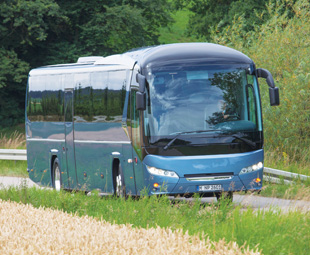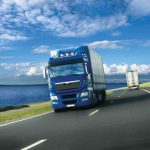The challenges of Euro-6

FRANK BEETON reports on important bus news from overseas.
The Euro-6 standards for commercial vehicles in Europe applies equally to buses and coaches – and for manufacturers active on both sides of the market, such as MAN Truck & Bus AG, the incorporation of countermeasures necessary to achieve the required 80 percent reduction of NOx over Euro-5 levels poses specific technical challenges.
The Euro-6 requirements are extremely demanding. They go beyond the setting and enforcement of more stringent emission standards, and require that the vehicle’s onboard diagnostic facilities include permanent monitoring of emission values, with a visual warning to the driver if the prescribed limits are exceeded. The quality and quantity of AdBlue solution in the Selective Catalytic Reduction system also needs to be monitored, which has dictated the introduction of heated storage tank and supply lines in case the ambient temperature drops below the liquid’s freezing point of minus 11,5°C. Further, the regulations stipulate that the vehicle’s emissions must be guaranteed stable for seven years or 700 000 km.
MAN’s available technology for compliance included exhaust gas recirculation (EGR), diesel particulate filter and selective catalytic reduction (SCR) techniques, all of which have been proven in previous vehicle generations. The enhanced emission performance demanded by Euro-6 has, however, prompted the use of demand-controlled and cooled EGR, and an SCR catalytic converter with integrated oxidation catalytic converter plus a continuously regenerating trap filter. Electronic sensors are included to permanently monitor the absorption capacity of the particulate filter and the NOx emission levels. On the induction side of the engine, MAN has applied common-rail fuel injection with pressures up to 1 800 bar, and two-stage turbocharging when outputs of 162 kW (220 hp) and above are required, while its design objectives have included low fuel consumption, minimal AdBlue consumption and high levels of reliability.
The situation where passenger vehicles require specific interventions has become more prevalent as the technical configurations of buses and coaches have increasingly moved away from those of goods vehicles. This has dictated the development of unique packages. For example, MAN has arranged the CRT and SCR converters one behind the other, in separate boxes, for its city bus application in order to retain the same passenger capacity that could be accommodated in the previous generation EEV-compliant (enhanced environmentally friendly vehicle) product. It has also been obliged to implement mass saving measures elsewhere in the vehicle’s design to offset the increases generated by the inclusion of the additional equipment dictated by the Euro-6 standards. Compliant power outputs ranging from 184 kW (250 hp) to 265 kW (360 hp) will be available for this vehicle class, and MAN claims that its Euro-6 solution will bring fuel consumption savings of three to five percent for its city buses. In coach and intercity bus applications, the range of Euro-6-compliant outputs will range from 184 kW (250 hp) to 371 kW (505 hp), and will feature a compact system in which all the required functions and monitoring devices are completely integrated into the rear silencer. This is expected to add between 150 and 200 kg to the vehicle’s unladen mass. MAN’s Euro-6 range will also include buses capable of using compressed natural gas and biogas fuels.
And a new Jetliner …
MAN also added a new entry-level two-axled coach to its premium coach model range recently. The Neoplan Jetliner is available in two lengths – 12,29 m (providing up to 53 seats) and 13,05 m (accommodating a maximum of 57 passengers) – with common widths and heights of 2,55 m and 3,4 m respectively. Power is provided by a 10,5-litre MAN D2066 EGR engine, with outputs of 264 kW (360 hp) or 294 kW (400 hp), driving through six-speed manual, ZF EcoLife six-speed automatic, or MAN TipMatic Coach 12-speed automated transmissions. Final drive is provided by MAN’s hypoid axles, with alternative ratios available to accommodate the operator’s application. Safety features include electronic brakes, ABS, braking assistant, traction control, electronic stability programme, tyre pressure monitoring and maximum speed control.
Published by
Focus on Transport
focusmagsa




